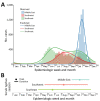Epidemiologic Changes of Scrub Typhus in China, 1952-2016
- PMID: 32441637
- PMCID: PMC7258452
- DOI: 10.3201/eid2606.191168
Epidemiologic Changes of Scrub Typhus in China, 1952-2016
Abstract
Scrub typhus, a miteborne rickettsiosis, has emerged in many areas globally. We analyzed the incidence and spatial-temporal distribution of scrub typhus in China during 1952-1989 and 2006-2016 using national disease surveillance data. A total of 133,623 cases and 174 deaths were recorded. The average annual incidence was 0.13 cases/100,000 population during 1952-1989; incidence increased sharply from 0.09/100,000 population in 2006 to 1.60/100,000 population in 2016. The disease, historically endemic to southern China, has expanded to all the provinces across both rural and urban areas. We identified 3 distinct seasonal patterns nationwide; infections peaked in summer in the southwest, summer-autumn in the southeast, and autumn in the middle-east. Persons >40 years of age and in nonfarming occupations had a higher risk for death. The changing epidemiology of scrub typhus in China warrants an enhanced disease control and prevention program.
Keywords: China; Orientia tsutsugamushi; bacteria; incidence; scrub typhus; seasons; surveillance; trends; vector-borne infections; zoonoses.
Figures





References
Publication types
MeSH terms
LinkOut - more resources
Full Text Sources

